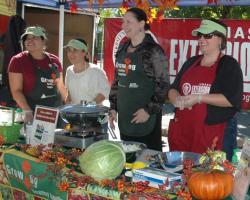The annual report for fiscal year 2016 from the University of Massachusetts Extension Nutrition Education Program (NEP) is full of impressive statistics. Through the power of numbers, one quickly gets a rundown of how many people are making healthier choices through direct work within communities. Bottom line: we are helping a whole lot of people in need find their way to healthier nutrition.
What is SNAP-Ed and EFNEP? They are two NEP research-based nutrition programs at UMass:
 SNAP-Ed provides a variety of nutrition education programs and resources to adults and youth who are receiving or are eligible for Supplemental Nutrition Assistance Program (SNAP) benefits.
SNAP-Ed provides a variety of nutrition education programs and resources to adults and youth who are receiving or are eligible for Supplemental Nutrition Assistance Program (SNAP) benefits.
 Expanded Food and Nutrition Education Program (EFNEP) provides practical, skill-based nutrition education to low-income families with young children and youth from low-income families.
Expanded Food and Nutrition Education Program (EFNEP) provides practical, skill-based nutrition education to low-income families with young children and youth from low-income families.
These numbers tell the story: A trend upwards in every area of participation
SNAP-Ed Summary
- Total Participants: 62,847 (4,089 adults and 58,758 youth)
- Total contacts with SNAP-Ed participants: 230,843
- Statewide NEP offices conducted 156 farmers’ market food demonstrations, reaching 11,682 shoppers
- SNAP-Ed Nutrition Education was delivered at 422 sites including: adult education and job training programs, community centers, daycare and preschool programs, farmers’ markets, Head Start programs, public schools, SNAP office sites, and more.
Youth behavior changes after participating in programs
- Youth (grades 3-8) ate more fruits and vegetables and were more physically active after completing a series of nutrition lessons
- Youth (grades 6-8) spent less time watching TV or movies, playing electronic games , or using the computer for non-school work after completing a series of nutrition lessons
Teacher Evaluation survey results (grades 3-8)
- 84.6% of classroom teachers reported that students who attended a series of nutrition education workshops were “very engaged” in the lessons.
- 94.3% reported that their students are more aware of the importance of good nutrition and healthy eating after the lessons
- 52.8% responded that their students make healthier meal and/snack choices after the lessons
- 51.6% responded that their students eat breakfast more often after the lessons
- 52.5% responded that their students are more physically active after the lessons
- 67.6% responded that their students are more willing to try new foods after the lessons
- One teacher said: “I love that my students learn about healthy food then go to the cafeteria and actually want to eat healthy.” Another offered: “This program is excellent, well run, and so informative for my students. I found it helpful for my lifestyle as well. Thank you so much!”
Making the healthier choice the easier choice at SNAP-Ed local program offices
Western Region - Springfield: Provided a series of lessons on the importance of breakfast and resources to support and reinforce the implementation of breakfast in the classroom
Southeast Region - Raynham: Conducted family cooking nights in Brockton and Randolph to provide healthy food demonstrations, recipes, and nutrition cooking and nutrition tips to keep families healthy
Northeast Region - Lawrence: Collaborated with local schools to support the Fresh Fruit and Vegetable Program (FFVP) by teaching nutrition lessons for students and providing talking points to reinforce healthy snacks to teachers
Central Region - Worcester: Partnered with Rainbow Child Center for low-income families and a local chef to conduct cooking and nutrition lessons for parents
Greater Boston Region : Conducted monthly food demonstrations at food pantries using ingredients that participants receive in pantry bags
Cape Cod Region - Barnstable: Collaborated with Cape Cod Hunger Network to adopt the Grow and Give project, linking area farmers and home gardeners with donations of fresh produce to local food pantries
EFNEP Summary
Participants: Total 4,228
Reaching Those in Need
- 79% of our adult EFNEP participants were from households living at or below the poverty level
- 85% of these households were receiving food assistance (such as WIC or SNAP benefits)
Changing Adult Behaviors from 2015-2016
- 94% made a positive change in dietary intake for at least one food group
- 84% improved one or more food resource management practices
- 65% improved one or more food safety practices
- 88% improved one or more nutrition practices
- 30% increased daily physical activity
Summary of Improvement for All Children and Youth
- 71% improved their abilities to choose foods according to Federal Dietary Recommendations
- 49% used safe food handling practices more often
- 71% improved their ability to prepare simple, nutritious, affordable food
- 24% improved their physical activity practices
- 67% acquired skills to be food secure
Food (In)security in Massachusetts
The U.S. Department of Agriculture's annual report on food security most recent figures are from September, 2014. Numbers revealed that some 9.6 percent of Massachusetts households struggled at some point during that year to provide food for their families. Put another way, 200,000 kids across Massachusetts are food insecure.
In 2013, Project Bread, a non-profit, anti-hunger organization based in Boston discovered that the 2014 figure can actually be a bit misleading: while 9.6 percent represents that roughly one in ten households experiences worry about whether there will be enough to eat, those people are not evenly distributed in our cities and towns. In some communities in Massachusetts, seven in 10 households are living in poverty.
Ultimately, the state's poverty level lands at just above 8 percent—the same as it was in 2010 according to the U.S. Census data released in September 2015. So for those who were struggling before and during the Great Recession, there's been no light at the end of the tunnel. They are still hungry.
It is not too dramatic to say that Massachusetts food programs save lives. SNAP-Ed and EFNEP work in combination to offer programs that the University of Massachusetts administers across the state. And they are the university’s only statewide program. It is noteworthy that these programs employ and train people in their own communities and some of those employees were former SNAP-Ed recipients. Lynn Beattie, NEP Materials, Evaluation & Training Manager, says, “UMass NEP is reaching individuals, families, and communities with the knowledge and skills for healthier eating and more physically active lifestyles. We support the work of more than 100 partners across Massachusetts to improve the lives of our participants.”
The overarching state agency administering SNAP-Ed programs is the Massachusetts Department of Transitional Assistance, Boston. The four SNAP-Ed implementing agencies statewide include: University of Massachusetts Extension; Share Our Strength/Cooking Matters Massachusetts, Boston; Ascentria Care Alliance (Formerly Lutheran Social Services of New England), Westfield; and Bay Cove Human Services, Dorchester.
